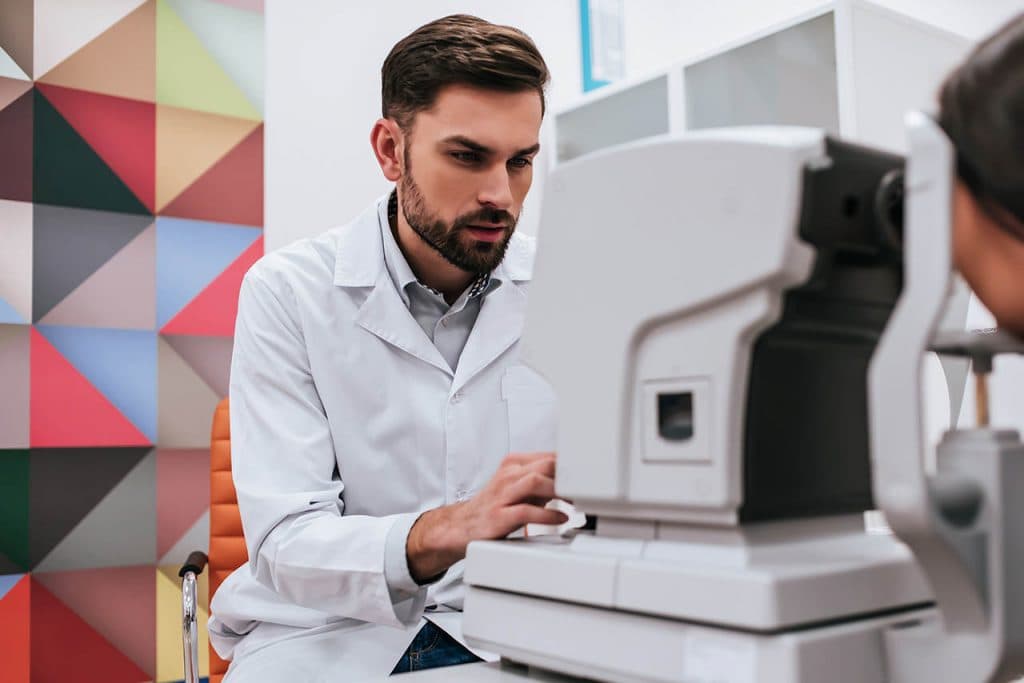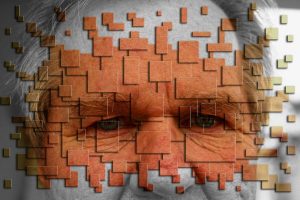Have you been told you have an eye disease or need eye surgery?
This guide will help you understand the 4 most common eye conditions: Cataract, Glaucoma, Macular Degeneration and Diabetic Retinopathy.
1. Cataracts
A cataract is the clouding of the eye’s transparent lens, that causes blurry vision. This condition usually develops gradually over time, and is the most common cause of vision loss in people over age 45.
- Cataracts affect more than 50% of all adults above the age of 80.
- By the age of 60, more than half of all adults will begin to develop a cataract.
- With more than 20 million cases, cataracts are one of the leading causes of blindness, worldwide.
A cataract does not cause pain or significant ocular discomfort and generally takes many decades before you notice any signs of the condition.
The main function of the eye’s lens is to ensure that light can pass through, to be focused on the retina at the back of the eye. The lens is also responsible for adjusting the eye’s focus, to enable clear vision at all distances.
For example, when driving a car, the lens changes focus so you can clearly see the road or street sign ahead, then look down at your speedometer, and back to the road.
The lens is mostly made up of water and protein and this protein in the eye lens is naturally arranged to keep the lens clear and allow light to pass through efficiently. As we age, a cataract may develop as a result of proteins losing their transparency and collecting together, “clouding” part of the lens. Over time, the cataract may worsen and affect more of the lens, making it more difficult to see clearly.
A typical way of understanding the visual effects of a cataract is that the vision is similar to that experienced when looking through a very dirty window.
The majority of cataracts develop due to the natural aging process. However, other types of cataracts due exist. Congenital cataracts are present at birth, secondary cataracts can result from eye surgery or diseases (i.e. glaucoma or diabetes), and traumatic cataracts can develop from an eye injury.
The symptoms people experience from cataracts may differ — depending on the individual, and the type of cataract. Some people experience a phenomenon known as “second sight”, in which near vision improves for a short time, typically until the cataract worsens.
Common signs and symptoms of a cataract
- Blurry or cloudy vision
- Glare- sunlight, bulbs, headlights
- Seeing halos around lights
- Poor night vision
- Colors appearing less vibrant
- Double vision
The early symptoms of cataracts can be treated by wearing anti-glare sunglasses, glasses with magnification lenses, or a stronger optical prescription.
Cataract surgery will be recommended when the cataracts begin to seriously impair your vision— affecting daily activities, such as reading, crafts, driving or watching TV.
Cataract surgery is a common, and relatively painless procedure that involves replacing your clouded eye lens with a clear, plastic intraocular lens (IOL) that contains an optical power to correct any refractive errors and improve vision clarity.
Improved vision is typically noticed soon after the surgery, with continued improvement over the following days and weeks.
If you suspect you have an eye condition, contact an eye doctor near you, who can diagnose and treat the condition.
SEE RELATED: Asteroid Hyalosis
2. Macular degeneration
Macular degeneration, also known as Age-related Macular Degeneration (AMD), is an ocular disease caused by deterioration of the macula, the center of the retina that controls your visual acuity.
- AMD accounts for 8.7% of all blindness worldwide.
- AMD is the leading causes of blindness in adults over the age of 60.
Macular degeneration causes dark “blind” spots to appear in the center of an image, with gradual loss of central vision. The disease affects performance of visual tasks that include fine details— reading, driving, recognizing faces, using a computer, watching TV, etc.
Types of AMD
- Dry macular degeneration is the most common form, and can be detected during a routine eye exam. It is considered the less aggressive form of AMD since it progresses slowly over many years or decades, and the clarity of vision slowly decreases over this time. It can result from aging and thinning of the macula, pigment in the macula, or a combination of the two causes.
-
- Dry AMD accounts for 80-90% of AMD cases.
-
- Wet macular degeneration is the more severe form of AMD. It usually develops rapidly as a result of abnormal blood vessel growth beneath the retina and leakage of blood and fluid, causing the development of blind spots and sudden loss of central vision.
It is crucial for AMD to be diagnosed and treated in its early stages to prevent severe vision loss and sometimes even blindness.
Early signs of AMD
- Blurry vision
- Cloudy vision
- Dark ‘blind’ spots
Signs of AMD in its advanced stages
- Sudden, severe vision loss
- Larger blind spots
- Loss of central vision
Although there is no cure for AMD, there are treatments that can help to slow the advancement of the disease, preserve existing vision, and sometimes even improve vision loss.
Treatment for dry AMD includes slowing the progression of the disease, using high doses of zinc and antioxidants. The Age-Related Eye Disease Study (AREDS) shows that consumption of a specific formula of nutritional supplements containing high doses of antioxidants and zinc, may reduce AMD progression for those who have moderate AMD, and those with advanced AMD, in one eye.
Results of a follow-up study called AREDS2, show that consumption of lutein and zeaxanthin reduced the risk of AMD progression by 19 percent, and vision loss by 25 percent.
Treatment for wet AMD involves stopping the development of new blood vessels, destroying existing blood cells, and preventing leakage into the macula. Treatment methods include laser surgery, eye injections, or AMD medication.
Contact an eye doctor near you to diagnose and treat your AMD.
3. Glaucoma
Glaucoma is a progressive ocular disease that causes vision loss from damage to the optic nerve, which is responsible for carrying visual signals between the eye and brain.
- Glaucoma is a leading cause of irreversible blindness, worldwide and accounts for 12.3% of global blindness.
- Glaucoma affects up to 5% of the people aged 70+ years and increases to over 9% for those aged 80+ years.
Glaucoma most commonly develops when there is high pressure inside the eye (intraocular pressure, IOP), caused by a build-up of fluid inside that cannot drain from the eye properly. The damage to the optic nerve affects peripheral vision first, and then central vision, causing partial or complete vision loss.
Glaucoma has been nicknamed the “Silent Thief of Sight ” because it causes vision loss before the person notices any symptoms.
Unfortunately, a cure for glaucoma and the ability to reverse it’s damage has yet to be discovered.
However, there are treatments available to help stop, or at least reduce, the progression of the disease by lowering or controlling your IOP. Glaucoma eye drops are a very effective treatment option, and are often the first plan of action.
While most cases of glaucoma can be controlled with medicated eye drops, in some cases, surgery may be preferred or considered more effective. Glaucoma surgery involves creating a new opening for fluid drainage to reduce IOP.
A new surgical technique called MIGS (minimally invasive glaucoma surgery) uses microscopic tools and devices— offering patients an effective treatment option, with a lower risk of complications.
Schedule an eye exam, so that an eye doctor can diagnose and treat your glaucoma.
4. Diabetic retinopathy
Diabetic retinopathy is a serious sight-threatening complication of diabetes that can lead to blindness.
Diabetic retinopathy is an ocular disease that causes vision loss and blindness in people who have diabetes. The disease is caused by high levels of sugar in the bloodstream and results in progressive damage to the light detecting retina responsible for sending visual signals to the brain.
- Diabetic retinopathy affects 1 in 3 people with diabetes.
- 1 in 2 people are unaware that they have diabetic retinopathy.
- 95% of people with diabetic retinopathy can avoid severe vision loss with early treatment.
Stages of the disease
1 Non-Proliferative Retinopathy (NPR), also called Background Retinopathy, is the earliest stage of the disease. In this stage, high blood sugar concentration in the retina causes micro-aneurysms, in which damage to the walls of the tiny retinal capillaries occurs. Micro-aneurysms eventually rupture and bleed and due the shape, are called “dot-and-blot” hemorrhages.
2. Proliferative Retinopathy (PR) is the more severe form of the disease. In this stage, abnormal blood vessels begin to grow in the retina. If these new blood vessels break, it can trigger bleeding into the vitreous, gelatinous matter that fills the eye— causing retinal scarring, severe vision difficulties, and even blindness.
Diabetic macular edema (DME) is a complication of diabetic retinopathy. DME occurs when damaged blood vessels leak fluid into the macula— the part of the retina responsible for sharp central vision that allows you to see fine details. Diabetic macular edema may cause blurry or wavy vision, blind spots, and cause colors to appear dull. These symptoms can impact reading, writing, driving, and facial recognition
Symptoms of diabetic retinopathy
- Blurry vision
- Cloudy vision
- Double vision
- Seeing floaters
- Increasing scotomas (dark spots)
- Near vision difficulty
- Poor night vision
If you experience any of these symptoms contact an eye doctor near you.
Treatment for diabetic retinopathy depends on the stage of the disease. Treatment options include anti-VEFG injections to block protein production that causes blood vessels to leak and abnormal blood vessels to grow, laser surgery to seal blood vessels from leaking, or a vitrectomy to remove the blood in the vitreous humor.
Untreated diabetic retinopathy can lead to many complications, and even blindness. However, with proper treatment, and maintenance of healthy blood sugar levels, many symptoms of diabetic retinopathy can be reversed.
Why are comprehensive eye exams important?
Quite often, symptoms of an ocular disease are only noticed after the disease has progressed to a more advanced stage.
Comprehensive eye exams are crucial for monitoring changes in your ocular health, and facilitating early detection of ocular disease.
LEARN MORE: Guide to Eye Conditions
If you are experiencing any changes in your vision, schedule an eye exam for a comprehensive evaluation of your ocular health.
An early diagnosis of ocular disease can reduce vision loss, preserve remaining eyesight, and in some cases even restore vision that has been lost.










